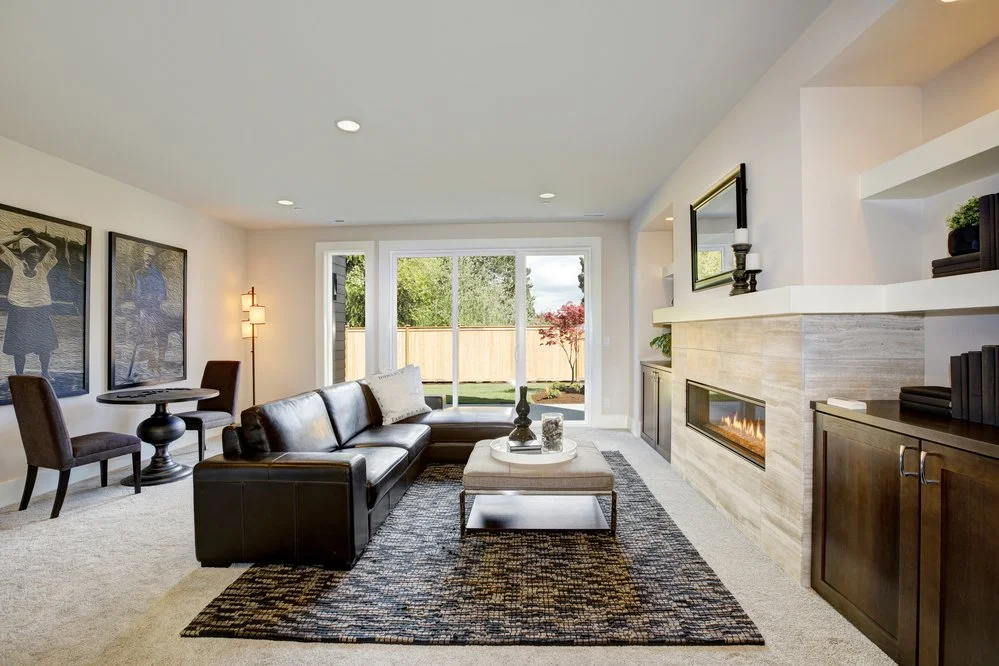How to Soundproof Your Basement and Why You Should
/Finishing or renovating your basement is a great way to add additional square footage and usable living space to your home. Whether it's a space for entertaining, sleeping, cooking or you plan to make it into an apartment for your adult child or elderly parent, it can add a lot of value to your home.
However, one step you don't want to skip is soundproofing your basement. There's nothing worse than hearing all of the noise from your teenager downstairs with his friends, or your mom complaining that she can't get to sleep at 10 p.m. because the noise from the TV you're watching on the main floor is keeping her awake. In this post we talk about how you can soundproof your basement to ensure it's comfortable for everyone in the household.
Prefer to listen?
Soundproof Your Basement Home Office
With so many of us working from home now, we've been creating home offices for our clients in the basement. We've always recommended that soundproofing be done during construction as it makes it very difficult to concentrate in your new home office if you're hearing the dog barking, kids screaming and playing, TVs blaring and so on. There are many things you can do to soundproof, depending on how much noise you need to deaden.
How Much Soundproofing Do You Need?
If you are unsure how much soundproofing you need before you finish your basement, spend some time in the basement while your family is living upstairs. Listen to see how much you hear and how much you think it will bother you. Even simple things like people walking around or items dropping can cause impact noise that will echo throughout the whole basement. Conversations can often be barely muted between floor levels, creating background noise that can interfere with your concentration or sleep.
Also consider how much noise will be created in the basement that will then transfer to the main floor. If you have your office in the basement and you’ll frequently be on conference calls or Zoom meetings, will your voice transfer to the main floor and disrupt a child that might be at home doing homework or studying?
If your basement space will be used as a place where your teenage son can hang out with all his friends playing video games, how much of that noise will transfer to the main floor and disrupt the family there?
How Does Sound Travel in Your Home?
There are three different ways that sound travels from one floor of a house to another. The first is airborne noise where sound waves travel through the airways. This type of noise originates from conversations, radio, TV, dogs barking and so on.
The second type of sound is mechanically transmitted. This is noise that travels through walls, ceilings and floors. An airborne sound wave will hit a solid structure and that wave becomes a vibration and is transmitted through the barriers.
The third type of sound is flanking noise. This is the sound that travels in direct paths from floor level to floor level. It can travel through joists, duct work or even vibrate through concrete floors.
The Best Solution for Soundproofing
Essentially, in order to produce complete soundproofing, it's best to soundproof in ways that will hit all three of these types of sounds. However, depending on your needs, you may not need to be that elaborate in your soundproofing. Below you will see several options for soundproofing.
Insulation
One of the easiest, least expensive and quickest ways to provide some soundproofing is to use sound-proofing insulation in the ceiling. We use Roxul Safe 'n Sound insulation for this purpose. It brings with it the added bonus of being a fire retardant as well.
This type of insulation is very easy to install and gets done before the drywall goes up. It deadens the sound from one floor to the next.
Another area where we've used sound-proofing insulation is around the mechanical room. Although the inside of the mechanical room is usually not finished, that doesn't mean the walls can't be insulated. If you’re entertaining, sleeping or watching TV in the basement, the noise from the mechanical room can be disruptive. Adding soundproofing insulation to the walls in the mechanical room will deaden the sound coming from the mechanisms within.
Decoupling
Another great way to deaden sound is decoupling. When you decouple, you are separating the levels by creating a gap between the joists or studs and ceiling layers or other solid surfaces. Most often we use resilient channels to accomplish this.
These channels break the path that sound waves travel and are one of the best solutions for noise transfer. When combined with insulation, it produces a very cost-efficient and effective sound barrier.
Drywall
Adding more mass can also make it difficult for noise to make it through the layers. Using a 5/8" drywall will help a little but it will only reduce the sound transfer by about three decibels. You can add a second sheet of 5/8" drywall as well for some additional soundproofing properties.
Acoustic drywall is another option that will provide even more sound dampening. It uses compounds to absorb and dampen sound waves and is much more effective than regular drywall. Although much more expensive than regular drywall, it is considerably more effective at soundproofing.
Other Options
Sound travels on airways so if air can get through somewhere between levels of your home then sound can too. If you really want to create a sound-tight barrier, acoustic caulking and foams are great for those hard-to-reach spaces.
Foam board or polystyrene panels can also be installed before the drywall goes up on the ceiling. These foam boards can reduce the mechanically transmitted sound and it also helps to decouple the floor levels.
Another option to consider before you even start any of the soundproofing and finishing up the ceiling, is to seal all areas where the light shines through to the basement from the floor above. Essentially, if light can penetrate then so will sound.
The best way to determine where light is penetrating is wait until it's dark outside, light up the floor above and then go into the dark basement and look for any light that's leaking through from above. Use a green glue noiseproofing sealant to seal any of the cracks or gaps. This product remains pliable so it won't shrink over time.
Soundproofing paint is another option but please note that it will only reduce sounds the equivalent of voices. If you're trying to deaden loud screaming or loud music, this won't do the trick. It's also best used in conjunction with other soundproofing techniques.
Soundproofing paint is heavy-bodied and is made of ceramic microspheres and special soundproofing fillers. Be prepared to put on several layers for best results.
In summary…
Soundproofing a space, particularly a basement, can really make a huge difference in how much you enjoy the space. Particularly if you’re planning on working in the basement or sleeping there, consider some level of soundproofing, even if you only soundproof the ceiling in that room.
























